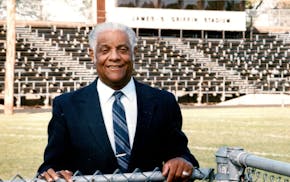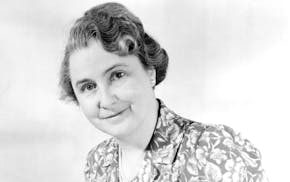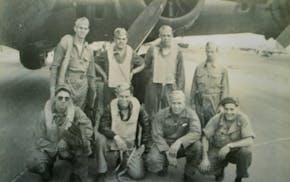One day when he was about 8 years old, Bill Heaney was hanging out with his father in the toolshed behind their home in Duluth.
"Daddy, we go fishing and I like that, but some of the other boys go hunting with their dads. How come we don't?'" Bill asked his dad.
Gerald Heaney turned to his son and said, "Billy, I saw too much killing in the war."
Bill Heaney, who turns 75 next month, told me: "The emotion in his words still resonates with me today."
Gerald Heaney, a butcher's son from Goodhue, Minn., was among the first soldiers who crashed through choppy waves toward Normandy's Omaha Beach as D-Day dawned on June 6, 1944 — 80 years ago next month.
"I'm in the boat and the front end goes down," Heaney recalled for a 2002 oral history project. Joe Rafferty, his friend and a captain in the Army's Second Rangers, hollered "Everyone ashore!" just before German machine gun fire tore through Rafferty, making him one of the first of the 2,400 casualties on the beach that day.
When the first lieutenant was also gunned down, Second Lt. Heaney, then 26, found himself next in command. "I looked up and said: 'We are not going out [the front]; everybody over the side.'"
As the troops thrust their rifles over their heads and trudged through chest-high waves with water-soaked packs, Heaney dropped his heavy pack so he could move through the surf. "The Germans had us zeroed in with mortars. ... We knew we couldn't stay there. So we leapt over the seawall across the road and started to make our way up the hill, where the German [machine-gun nests] were."
In the end, only 150 of the 600 members of his battalion survived the horrific invasion — considered the most decisive battle in World War II, if not world history. Hitler's Nazi regime fell nearly a year later.
"It wasn't the years of meticulous planning that won the day, nor the 175,000 troops that eventually landed," Minneapolis attorney Scott A. Johnson wrote in a 1999 article about Heaney. "It was the courage of a few hundred water-soaked, exhausted 20-year-old men — many dazed and wounded, lying on a foreign beach amid unimaginable noise, smoke, blood and confusion — that made the difference."
Heaney would go on to become a respected labor lawyer and a behind-the-scenes DFL Party power broker, a friend of Hubert Humphrey and Walter Mondale and eventually a federal appellate judge in Duluth. He died in 2010 at 92, after being married for 64 years to his college sweetheart, Eleanor Rose Schmitt. The federal courthouse in Duluth was named after him in 2007.
Heaney was "not a well-known person, but his contribution to his state and nation has been extraordinary," Mondale told the Star Tribune's Larry Oakes in 1995. "He deserves to have his story told."
Heaney attended the College of St. Thomas and then the University of Minnesota, where he earned a law degree in 1941 and would later serve as a regent.
When the Japanese bombed Pearl Harbor in 1941, Heaney tried to enlist in the U.S. Marines. They rejected him because he was color blind, but the Army accepted him in 1942 and eventually presented him with a chest full of medals and battle stars.
I learned about Heaney from Robert Hennessey, 81, who lives in Afton and was one of the judge's law clerks in the late 1960s. On a fishing trip in Canada, Heaney talked to him about D-Day.
In oral histories and interviews, Heaney recalled the night of the invasion, when he returned to the beach to scavenge weapons and ammunition from the corpses of his fellow soldiers. "The dead were still laying on the beach or half in the water and half out of the water, and some had floated out to sea," he said, calling it one of the most emotional moments of his time in the Army.
When the war ended in August 1945, Heaney asked to sail home with the surviving members of the Second Ranger Battalion. After his plea was twice rejected, he appealed in person to Gen. George Patton. When Patton learned that Heaney, by then a captain, had fought on D-Day and in the Hürtgen Forest, he told his adjutant: "Give this officer anything he wants!"
Before going home, Heaney found himself in Pilsen, Czechoslovakia, where a colonel ordered him to find an American flag for a victory parade. Neither dress shops nor seamstresses had any cloth, so Heaney drove to Prague and found two older women who hastily sewed together a large flag. He brought the flag home with him and unfurled it in countless parades over the years.
Bill Heaney, who splits his time between Arizona and Minnesota, said the flag remains in the family to this day.
"It's a symbol of everything they fought for," Bill said. "A symbol of what was right."
Curt Brown's tales about Minnesota's history appear every other Sunday. Readers can send him ideas and suggestions at mnhistory@startribune.com. His latest book looks at 1918 Minnesota, when flu, war and fires converged: strib.mn/MN1918.

Minnesota History: Ad man turned Paul Bunyan into a folklore icon

Minnesota History: James Griffin used persistence to blaze a trail for St. Paul's Black police officers

Minnesota History: For Granite Falls doctor who tested thousands of kids for TB, new recognition is long overdue

Minnesota History: A New Ulm baker wearing a blanket fell to friendly fire in the U.S.-Dakota War




